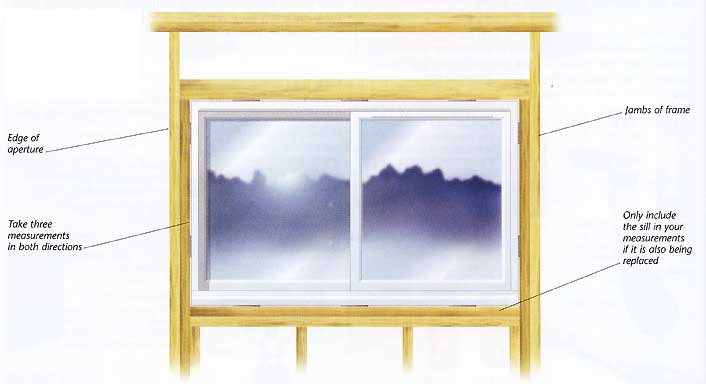If you are replacing an older window, it may need to be custom made, and you will need to measure carefully before ordering. When your window arrives, check that it's the right size. Then remove the old window before fitting the new frame (see opposite). Get professional advice before removing large windows -- there may be structural elements in their design. Consider your wall structure before removing the old window (see below).
WALL STRUCTURE
Determine whether your walls are solid masonry, cavity, or wood-framed. You may have to chip away some mortar, or pry off beading or cover strips around the window. Buy lumber or masonry frame attachments appropriate for the wall material. The wall above the window is supported by a steel, concrete, or wooden header. If you can gain access, check wooden headers for rot. Seek advice if it's present.
MEASURING FOR A REPLACEMENT WINDOW
Take vertical and horizontal measurements of the window opening (not the existing frame) in at least three places. If there is any variation use the shortest. Then, deduct in (10 mm) from each to give you the frame size for the new window. Take these measurements to your supplier. If you have wood-framed walls, in addition to the window opening, you should also measure the thickness of the walls. If the house is masonry-clad, the height and width of the opening in the masonry must be noted in addition to the dimensions of the window opening itself.

Measuring: Mistakes made while measuring can be costly,
so take time to measure accurately. Edge of aperture; Take three measurements
in both directions; jambs of frame; Only include the sill in your measurements
if it's also being replaced.
REMOVING THE OLD WINDOW
Don’t remove an old window until you have received the new one and checked it for damage. Otherwise you could be left with a hole in your wall. In some circumstances, before removing an old frame you may need to take out any sashes. If all the casements or sashes are removable, simply unscrew or lever them away with the glass intact. Carefully remove glass from fixed panes. You can then begin to remove the frame. Expect to find most, if not all of the fasteners through the jambs of the frame. While you are removing the frame, take care not to damage any flashing around the edges of the opening.
Removing a wooden-framed window
Use a panel saw to cut through the top and the bottom of one side. Angle your cuts toward the center of the side to create a wedge-shaped section that you can lever out easily. Lever away the side using a pry bar, taking care not to damage the wall (although some damage is often inevitable). Once you have removed the first section, it should be easier to remove the other sides. Remove any fasteners. Finally, clear away loose debris with a dusting brush.
Removing a metal-framed window
Use the same technique as for a wooden frame, but use a hacksaw or an angle grinder with a metal cutting blade (disk). When using an angle grinder, watch out for flying sparks, which can be a fire hazard.
Checking the window opening
If you have damaged any flashing around the window opening, it should be replaced. ouble-check for any rotten wood (see also Wall Structure, above). If you suspect rot or mold, seek professional advice.